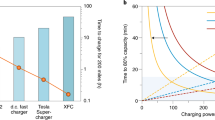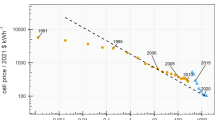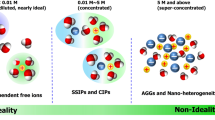Abstract
Batteries have shaped much of our modern world. This success is the result of intense collaboration between academia and industry over the past several decades, culminating with the advent of and improvements in rechargeable lithium-ion batteries. As applications become more demanding, there is the risk that stunted growth in the performance of commercial batteries will slow the adoption of important technologies such as electric vehicles. Yet the scientific literature includes many reports describing material designs with allegedly superior performance. A considerable gap needs to be filled if we wish these laboratory-based achievements to reach commercialization. In this Perspective, we discuss some of the most relevant testing parameters that are often overlooked in academic literature but are critical for practical applicability outside the laboratory. We explain metrics such as anode energy density, voltage hysteresis, mass of non-active cell components and anode/cathode mass ratio, and we make recommendations for future reporting. We hope that this Perspective, together with other similar guiding principles that have recently started to emerge, will aid the transition from lab-scale research to next-generation practical batteries.
This is a preview of subscription content, access via your institution
Access options
Access Nature and 54 other Nature Portfolio journals
Get Nature+, our best-value online-access subscription
$29.99 / 30 days
cancel any time
Subscribe to this journal
Receive 12 print issues and online access
$259.00 per year
only $21.58 per issue
Buy this article
- Purchase on Springer Link
- Instant access to full article PDF
Prices may be subject to local taxes which are calculated during checkout




Similar content being viewed by others
References
Kasavajjula, U., Wang, C. S. & Appleby, A. J. Nano- and bulk-silicon-based insertion anodes for lithium-ion secondary cells. J. Power Sources 163, 1003–1039 (2007).
Bruce, P. G., Freunberger, S. A., Hardwick, L. J. & Tarascon, J. M. Li–O2 and Li–S batteries with high energy storage. Nat. Mater. 11, 19–29 (2012).
Girishkumar, G., McCloskey, B., Luntz, A. C., Swanson, S. & Wilcke, W. Lithium–air battery: promise and challenges. J. Phys. Chem. Lett. 1, 2193–2203 (2010).
Lu, J. et al. A lithium–oxygen battery based on lithium superoxide. Nature 529, 377 (2016).
Lu, J. et al. Aprotic and aqueous Li–O2 batteries. Chem. Rev. 114, 5611–5640 (2014).
Cui, L. F., Yang, Y., Hsu, C. M. & Cui, Y. Carbon–silicon core–shell nanowires as high capacity electrode for lithium ion batteries. Nano Lett. 9, 3370–3374 (2009).
Cui, L. F., Ruffo, R., Chan, C. K., Peng, H. L. & Cui, Y. Crystalline–amorphous core–shell silicon nanowires for high capacity and high current battery electrodes. Nano Lett. 9, 491–495 (2009).
Li, X. L. et al. Mesoporous silicon sponge as an anti-pulverization structure for high-performance lithium-ion battery anodes. Nat. Commun. 5, 7 (2014).
Feng, K. et al. Silicon-based anodes for lithium-ion batteries: from fundamentals to practical applications. Small 14, 1702737 (2018).
Chan, C. K. et al. High-performance lithium battery anodes using silicon nanowires. Nat. Nanotechnol. 3, 31–35 (2008).
Attia, E. N. et al. Tailoring the chemistry of blend copolymers boosting the electrochemical performance of Si-based anodes for lithium ion batteries. J. Mater. Chem. A 5, 24159–24167 (2017).
Cao, K., Jin, T., Yang, L. & Jiao, L. Recent progress in conversion reaction metal oxide anodes for Li-ion batteries. Mater. Chem. Front. 1, 2213–2242 (2017).
Zheng, G. et al. Interconnected hollow carbon nanospheres for stable lithium metal anodes. Nat. Nanotechnol. 9, 618 (2014).
Yang, Y., Zheng, G. Y. & Cui, Y. Nanostructured sulfur cathodes. Chem. Soc. Rev. 42, 3018–3032 (2013).
Liang, C. D., Dudney, N. J. & Howe, J. Y. Hierarchically structured sulfur/carbon nanocomposite material for high-energy lithium battery. Chem. Mater. 21, 4724–4730 (2009).
Song, J. X. et al. Nitrogen-doped mesoporous carbon promoted chemical adsorption of sulfur and fabrication of high-areal-capacity sulfur cathode with exceptional cycling stability for lithium–sulfur batteries. Adv. Funct. Mater. 24, 1243–1250 (2014).
Li, M. et al. Gas Pickering emulsion templated hollow carbon for high rate performance lithium sulfur batteries. Adv. Funct. Mater. 26, 8408–8417 (2016).
Li, M. et al. Compact high volumetric and areal capacity lithium sulfur battery through rock salt induced nano-architectured sulfur host. J. Mater. Chem. A 5, 21435–21441 (2017).
Li, G. et al. Stringed ‘tube on cube’ nanohybrids as compact cathode matrix for high-loading and lean-electrolyte lithium–sulfur batteries. Energy Environ. Sci. 11, 2372–2381 (2018).
Wei Seh, Z. et al. Sulphur–TiO2 yolk–shell nanoarchitecture with internal void space for long-cycle lithium–sulphur batteries. Nat. Commun. 4, 1331 (2013).
Lu, J. et al. Effect of the size-selective silver clusters on lithium peroxide morphology in lithium–oxygen batteries. Nat. Commun. 5, ncomms5895 (2014).
Lu, J. et al. A lithium–oxygen battery based on lithium superoxide. Nature 529, 377 (2016).
Li, Z., Fang, Y., Zhang, J. & Lou, X. W. Necklace-like structures composed of Fe3N@C yolk–shell particles as an advanced anode for sodium-ion batteries. Adv. Mater. https://doi.org/10.1002/adma.201800525 (2018).
Son, S.-B. et al. An artificial interphase enables reversible magnesium chemistry in carbonate electrolytes. Nat. Chem. 10, 532–539 (2018).
Li, M., Lu, J., Chen, Z. & Amine, K. 30 years of lithium-ion batteries. Adv. Mater. https://doi.org/adma.1800561 (2018).
Xiao, J. Understanding the lithium sulfur battery system at relevant scales. Adv. Energy Mater. 5, 1501102 (2015).
Sun, Y., Liu, N. & Cui, Y. Promises and challenges of nanomaterials for lithium-based rechargeable batteries. Nat. Energy 1, 16071 (2016).
Raccichini, R., Varzi, A., Wei, D. & Passerini, S. Critical insight into the relentless progression toward graphene and graphene-containing materials for lithium-ion battery anodes. Adv. Mater. 29, 1603421 (2017).
Gogotsi, Y. & Simon, P. True performance metrics in electrochemical energy storage. Science 334, 917–918 (2011).
Urbonaite, S., Poux, T. & Novák, P. Progress towards commercially viable Li–S battery cells. Adv. Energy Mater. 5, 1500118 (2015).
Freunberger, S. A. True performance metrics in beyond-intercalation batteries. Nat. Energy 2, 17091 (2017).
Hu, Y. S. et al. Synthesis of hierarchically porous carbon monoliths with highly ordered microstructure and their application in rechargeable lithium batteries with high-rate capability. Adv. Funct. Mater. 17, 1873–1878 (2007).
Landi, B. J., Ganter, M. J., Cress, C. D., DiLeo, R. A. & Raffaelle, R. P. Carbon nanotubes for lithium ion batteries. Energy Environ. Sci. 2, 638–654 (2009).
Yoo, E. et al. Large reversible Li storage of graphene nanosheet families for use in rechargeable lithium ion batteries. Nano Lett. 8, 2277–2282 (2008).
Sun, Y. Q., Wu, Q. O. & Shi, G. Q. Graphene based new energy materials. Energy Environ. Sci. 4, 1113–1132 (2011).
Lian, P. C. et al. Large reversible capacity of high quality graphene sheets as an anode material for lithium-ion batteries. Electrochim. Acta 55, 3909–3914 (2010).
Zhang, W. M., Wu, X. L., Hu, J. S., Guo, Y. G. & Wan, L. J. Carbon coated Fe3O4 nanospindles as a superior anode material for lithium-ion batteries. Adv. Funct. Mater. 18, 3941–3946 (2008).
Jiang, J. et al. Recent advances in metal oxide-based electrode architecture design for electrochemical energy storage. Adv. Mater. 24, 5166–5180 (2012).
Reddy, M. V., Rao, G. V. S. & Chowdari, B. V. R. Metal oxides and oxysalts as anode materials for Li ion batteries. Chem. Rev. 113, 5364–5457 (2013).
Buiel, E. & Dahn, J. R. Li-insertion in hard carbon anode materials for Li-ion batteries. Electrochim. Acta 45, 121–130 (1999).
Dahn, J. R., Zheng, T., Liu, Y. & Xue, J. S. Mechanisms for lithium insertion in carbonaceous materials. Science 270, 590–593 (1995).
Gallagher, K. G. et al. Correlating hysteresis and voltage fade in lithium- and manganese-rich layered transition-metal oxide electrodes. Electrochem. Commun. 33, 96–98 (2013).
Bettge, M. et al. Voltage fade of layered oxides: its measurement and impact on energy density. J. Electrochem. Soc. 160, A2046–A2055 (2013).
Wang, Z. Y., Luan, D. Y., Madhavi, S., Li, C. M. & Lou, X. W. α-Fe2O3 nanotubes with superior lithium storage capability. Chem. Commun. 47, 8061–8063 (2011).
Chen, J. et al. Improving lithium–sulfur battery performance under lean electrolyte through nanoscale confinement in soft swellable gels. Nano Lett. 17, 3061–3067 (2017).
Peng, H. J., Huang, J. Q., Cheng, X. B. & Zhang, Q. Review on high-loading and high-energy lithium–sulfur batteries. Adv. Energy Mater. 7, 1700260 (2017).
Wang, H. et al. Tailored reaction route by micropore confinement for Li–S batteries operating under lean electrolyte conditions. Adv. Energy Mater. 8, 1800590 (2018).
Cheng, L. et al. Sparingly solvating electrolytes for high energy density lithium–sulfur batteries. ACS Energy Lett. 1, 503–509 (2016).
Hagen, M. et al. Lithium–sulfur cells: the gap between the state-of-the-art and the requirements for high energy battery cells. Adv. Energy Mater. 5, 1401986 (2015).
Chung, S. H., Chang, C. H. & Manthiram, A. Progress on the critical parameters for lithium–sulfur batteries to be practically viable. Adv. Funct. Mater. 28 (2018).
Li, M. et al. A lithium–sulfur battery using a 2D current collector architecture with a large-sized sulfur host operated under high areal loading and low E/S ratio. Adv. Mater. 30, 1804271 (2018).
Fan, F. Y. & Chiang, Y.-M. Electrodeposition kinetics in Li–S batteries: effects of low electrolyte/sulfur ratios and deposition surface composition. J. Electrochem. Soc. 164, A917–A922 (2017).
Li, G. et al. 3D porous carbon sheets with multidirectional ion pathways for fast and durable lithium–sulfur batteries. Adv. Energy Mater. 8, 1702381 (2018).
Washburn, E. W. The dynamics of capillary flow. Phys. Rev. 17, 273–283 (1921).
Sheng, Y. et al. Effect of calendering on electrode wettability in lithium-ion batteries. Front. Energy Res. 2, 56 (2014).
Chung, S. H. & Manthiram, A. Rational design of statically and dynamically stable lithium–sulfur batteries with high sulfur loading and low electrolyte/sulfur ratio. Adv. Mater. 30 (2018).
Chung, S.-H. & Manthiram, A. Designing lithium–sulfur cells with practically necessary parameters. Joule 2, 710–724 (2018).
Fang, R. et al. More reliable lithium–sulfur batteries: status, solutions and prospects. Adv. Mater. 29, 1606823 (2017).
Liu, T. J., Tiu, C., Chen, L. C. & Liu, D. in Printed Batteries: Materials, Technologies and Applications (eds. Lanceros-Menez, S. & Costa, C. M.) 63–79 (Wiley, Hoboken, 2018).
Yang, X., Li, X., Adair, K., Zhang, H. & Sun, X. Structural design of lithium–sulfur batteries: from fundamental research to practical application. Electrochem. Energy Rev. 1, 239–293 (2018).
Nam, Y. J., Oh, D. Y., Jung, S. H. & Jung, Y. S. Toward practical all-solid-state lithium-ion batteries with high energy density and safety: comparative study for electrodes fabricated by dry- and slurry-mixing processes. J. Power Sources 375, 93–101 (2018).
Wang, Z. et al. A metal-organic-framework-based electrolyte with nanowetted interfaces for high-energy-density solid-state lithium battery. Adv. Mater. 30, 1704436 (2018).
Judez, X. et al. Solid electrolytes for safe and high energy density lithium–sulfur batteries: promises and challenges. J. Electrochem. Soc. 165, A6008–A6016 (2018).
Sun, Y. et al. High-capacity battery cathode prelithiation to offset initial lithium loss. Nat. Energy 1, 15008 (2016).
Adams, B. D., Zheng, J., Ren, X., Xu, W. & Zhang, J. G. Accurate determination of Coulombic efficiency for lithium metal anodes and lithium metal batteries. Adv. Energy Mater. 8, 1702097 (2018).
Zhang, Z. et al. Li2O-reinforced Cu nanoclusters as porous structure for dendrite-free and long-lifespan lithium metal anode. ACS Appl. Mater. Interfaces 8, 26801–26808 (2016).
Aurbach, D. & Granot, E. The study of electrolyte solutions based on solvents from the ‘glyme’ family (linear polyethers) for secondary Li battery systems. Electrochim. Acta 42, 697–718 (1997).
Aurbach, D., Gofer, Y., Ben-Zion, M. & Aped, P. The behaviour of lithium electrodes in propylene and ethylene carbonate: te major factors that influence Li cycling efficiency. J. Electroanal. Chem. 339, 451–471 (1992).
Lu, J., Wu, T. & Amine, K. State-of-the-art characterization techniques for advanced lithium-ion batteries. Nat. Energy 2, 17011 (2017).
Shishkin, Y. L. The effect of sample mass and heating rate on DSC results when studying the fractional composition and oxidative stability of lube base oils. Thermochim. Acta 444, 26–34 (2006).
Martín, J. L., Salla, J. M., Cadenato, A. & Ramis, X. Effects of experimental sample mass on the calorimetric study of thermoset resins. J. Thermal Anal. 38, 917–927 (1992).
Wang, Q. S. et al. Thermal runaway caused fire and explosion of lithium ion battery. J. Power Sources 208, 210–224 (2012).
Khateeb, S. A., Farid, M. M., Selman, J. R. & Al-Hallaj, S. Design and simulation of a lithium-ion battery with a phase change material thermal management system for an electric scooter. J. Power Sources 128, 292–307 (2004).
Yuan, Y., Amine, K., Lu, J. & Shahbazian-Yassar, R. Understanding materials challenges for rechargeable ion batteries with in situ transmission electron microscopy. Nat. Commun. 8, 15806 (2017).
Lowe, M. A., Gao, J. & Abruña, H. D. Mechanistic insights into operational lithium–sulfur batteries by in situ X-ray diffraction and absorption spectroscopy. RSC Adv. 4, 18347–18353 (2014).
Ren, Y. & Zuo, X. Synchrotron X-ray and neutron diffraction, total scattering, and small-angle scattering techniques for rechargeable battery research. Small Methods 2, 1800064 (2018).
Wang, X.-L. et al. Visualizing the chemistry and structure dynamics in lithium-ion batteries by in-situ neutron diffraction. Sci. Rep. 2, 747 (2012).
Yu, X. et al. Simultaneous operando measurements of the local temperature, state of charge, and strain inside a commercial lithium-ion battery pouch cell. J. Electrochem. Soc. 165, A1578–A1585 (2018).
Schmuch, R., Wagner, R., Hörpel, G., Placke, T. & Winter, M. Performance and cost of materials for lithium-based rechargeable automotive batteries. Nat. Energy 3, 267–278 (2018).
Eroglu, D., Zavadil, K. R. & Gallagher, K. G. Critical link between materials chemistry and cell-level design for high energy density and low cost lithium–sulfur transportation battery. J. Electrochem. Soc. 162, A982–A990 (2015).
McGrogan, F. P. et al. Compliant yet brittle mechanical behavior of Li2S–P2S5 lithium-ion-conducting solid electrolyte. Adv. Energy Mater. 7, 1602011 (2017).
Kim, J. H., Kim, J. S., Lim, Y. G., Lee, J. G. & Kim, Y. J. Effect of carbon types on the electrochemical properties of negative electrodes for Li-ion capacitors. J. Power Sources 196, 10490–10495 (2011).
Fan, Z. J. et al. Porous graphene networks as high performance anode materials for lithium ion batteries. Carbon 60, 558–561 (2013).
Zheng, J. et al. Structural and chemical evolution of Li-and Mn-rich layered cathode material. Chem. Mater. 27, 1381–1390 (2015).
Lv, D. et al. High energy density lithium–sulfur batteries: challenges of thick sulfur cathodes. Adv. Energy Mater. 5, 1402290 (2015).
Acknowledgements
The authors acknowledge support from the US Department of Energy (DOE), Office of Energy Efficiency and Renewable Energy, Vehicle Technologies Office. PNNL is operated by Battelle for DOE under contract no. DE-AC05-76RL01830. Argonne National Laboratory is operated for DOE by UChicago Argonne, LLC, under contract no. DE-AC02-06CH11357. Y.C. acknowledges financial support from the National Key Research Program of China (no. 2016YFB0100200). M.L. acknowledges financial support from the Natural Sciences and Engineering Research Council of Canada (NSERC) and the Waterloo Institute for Nanotechnology (WIN).
Author information
Authors and Affiliations
Corresponding authors
Ethics declarations
Competing interests
The authors declare no competing interests.
Additional information
Publisher’s note: Springer Nature remains neutral with regard to jurisdictional claims in published maps and institutional affiliations.
Rights and permissions
About this article
Cite this article
Cao, Y., Li, M., Lu, J. et al. Bridging the academic and industrial metrics for next-generation practical batteries. Nat. Nanotechnol. 14, 200–207 (2019). https://doi.org/10.1038/s41565-019-0371-8
Received:
Accepted:
Published:
Issue Date:
DOI: https://doi.org/10.1038/s41565-019-0371-8
This article is cited by
-
Methylation enables the use of fluorine-free ether electrolytes in high-voltage lithium metal batteries
Nature Chemistry (2024)
-
Cation replacement method enables high-performance electrolytes for multivalent metal batteries
Nature Energy (2024)
-
A survey on design optimization of battery electric vehicle components, systems, and management
Structural and Multidisciplinary Optimization (2024)
-
Electrode Conditions of Lithium-Ion Cell for Achieving High Energy Density
Korean Journal of Chemical Engineering (2024)
-
Advances in All-Solid-State Lithium–Sulfur Batteries for Commercialization
Nano-Micro Letters (2024)



